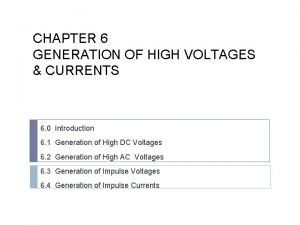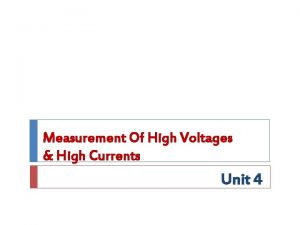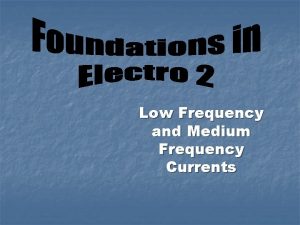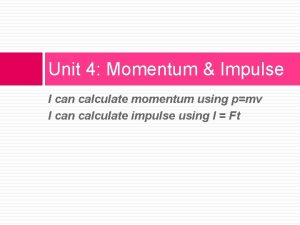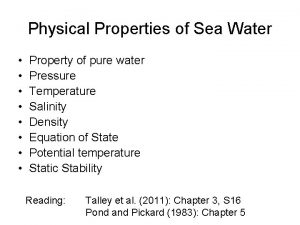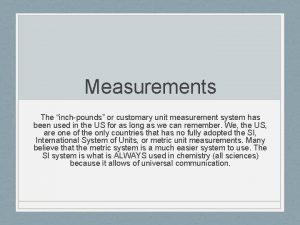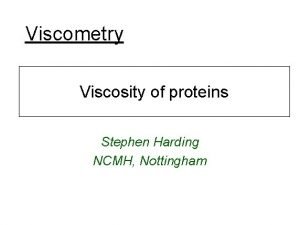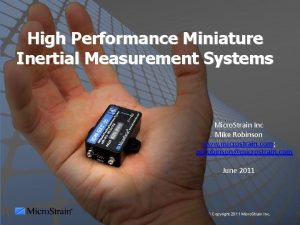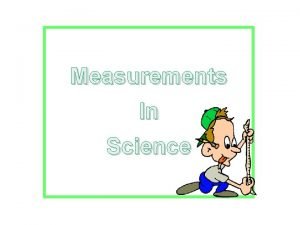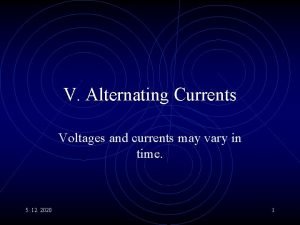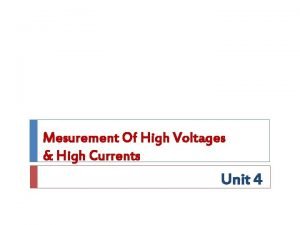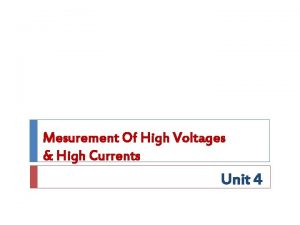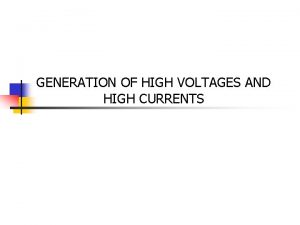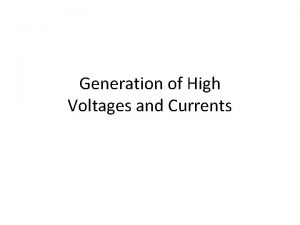Measurement Of High Voltages High Currents Unit 4

















- Slides: 17

Measurement Of High Voltages & High Currents Unit 4

High Voltage Measurement Techniques 2

Measurement Of High DC Voltage Series Resistance Micrometer Resistance Potential Divider Generating Voltmeter Sphere and Other Gaps 3

Sphere Gaps Applicatios: Voltage Measurement (Peak) - Peak values of voltages may be measured from 2 k. V up to about 2500 k. V by means of spheres. Arrangements: 4 1. Vertically with lower sphere grounded (For Higher Voltages) 2. Horizontally with both spheres connected to the source voltage or one sphere grounded (For Lower Voltages).

Sphere Gaps 5

Sphere Gaps The arrangement is selected based on the relation between the peak voltage, determined by sparkover between the spheres, and the reading of a voltmeter on the primary or input side of the high-voltage source. This relation should be within 3% (IEC, 1973). Standard values of sphere diameter are 6. 25, 12. 5, 25, 50, 75, 100, 150, and 200 cm. The Clearance around the sphere gaps: Fig C : Breakdown voltage characteristic of sphere gaps 6

Sphere Gaps The effect of humidity is to increase the breakdown voltage of sphere gaps by up to 3%. Temperature and pressure, however, havea significant influenceo n breakdown voltage. Breakdown Voltage under normal atmospheric conditions is, Vs=k. Vn where k is a factor related to the relative air density (RAD) δ. The relation between the RAD(δ) and the correction factor k: Under impulse voltages, the voltage at which there is a 50% breakdown probability is recognized as the breakdown level. 7

Sphere Gaps Factors Influencing the Sparkover Voltage of Sphere Gaps i. Nearby earthed objects, ii. Atmospheric conditions and humidity, iii. Irradiation, and iv. Polarity and rise time of voltage waveforms. The limits of accuracy are dependant on the ratio of the spacing d to the sphere diameter D, as follows: d < 0. 5 D Accuracy = ± 3 % 0. 75 D > d > 0. 5 D Accuracy = ± 5 % For accurate measurement purposes, gap distances in excess of 0. 75 D are not used 8

Sphere Gaps 9

High Ohmic Series Resistance with Microammeter Resistance (R) : Constructed with large wire wound Value: Few hundreds of Mega ohms –Selected to give (1 -10μA) for FSD. Voltage drop in each element is chosen to avoid surface flashovers and discharges (5 k. V/cm in air, 20 k. V/cm in oil is allowed) Provided with corona free terminals. Material: Carbon alloy with temperature coefficient of 10 -4/o. C. Resistance chain located in air tight oil filled PVC tube for 100 k. V operation with good temp stability. Mircoammeter – MC type Voltage of source, V=IR 10

High Ohmic Series Resistance with Microammeter Impedance of the meter is few ohms. i. e, very less compared to R so the drop across the meter is negligible. Protection: Paper gap, Neon Glow tube, a zener diode with series resistance – Gives protection when R fails. Maximum voltage: 500 k. V with 0. 2% accuracy. Limitations: 11 Power dissipation & source loading Temp effects & long time stability Voltage dependence of resistive elements Sensitivity to mechanical stresses

Resistance Potential Divider It uses electrostatic voltmeter or high impedance voltmeter. Can be placed near the test object which might not always be confined to one location Let, V 2 -Voltage across R 2 Sudden voltage changes during transients due to: Switching operation Flashover of test objects Damage due to stray capacitance across the elements & ground capacitance To avoid sudden changes in voltages, voltage controlling capacitors are connected across the elements 12

Resistance Potential Divider At high voltage ends, corona free termination is used to avoid unnecessary discharges. Accuracy: 13 0. 05% accuracy up to 100 k. V 0. 1% accuracy up to 300 k. V 0. 5% accuracy for 500 k. V

Generating Voltmeter Generating voltmeter: A variable electrostatic voltage generator. It generates current proportional to voltage under measurement. This arrangement provides loss free measurement of DC and AC voltages It is driven by synch. motor, so doesn’t observe power from the voltage measuring source The high voltage electrode and the grounded electrode in fact constitute a capacitance system. The capacitance is a function of time as the area A varies with time and, therefore, the charge q(t) is given as, 14 capacitor

Generating Voltmeter and, For d. c. Voltages, Hence If the capacitance C varies sinusoidally between the limits C 0 and (C 0 + Cm) then C = C 0 + Cm sin ωt and the current ‘i' is then given as, i(t) = im cos ω t , where im = VCmω Here ω is the angular frequency of variation of the capacitance. Generally the current is rectified and measured by a moving coil meter Generating voltmeters can be used for a. c. voltage measurement also provided the angular frequency ω is the same or equal to half that of the voltage being measured. Above fig. shows the variations of C as a function of time together with a. c. voltage, the frequency of which is twice the frequency of C (t). 15

Generating Voltmeter Instantaneous value of current i(t) = Cm fv. V(t) where fv = 1/Tv the frequency of voltage. Since fv = 2 fc and fc =1/( 60/n) we obtain, I(t) = (n/30) Cm. V(t) Fig. shows a schematic diagram of a generating voltmeter which employs rotating vanes for variation of capacitance High voltage electrode is connected to a disc electrode D 3 which is kept at a fixed distance on the axis of the other low voltage electrodes D 2, D 1, and D 0. The rotor D 0 is driven at a suitable constant speed by a synchronous motor. Rotor vanes of D 0 cause periodic change in capacitance between the insulated disc D 2 and the high voltage electrode D 3. Number and shape of vanes are so designed that a suitable variation of capacitance (sinusodial or linear) is achieved. The a. c. current is rectified and is measured using moving coil meters. If the current is small an amplifier may be used before the current is measured. 16

Generating Voltmeter Generating voltmeters are linear scale instruments and applicable over a wide range of voltages. The sensitivity can be increased by increasing the area of the pick up electrode and by using amplifier circuits Advantages: i. Scale is linear and can be extrapolated ii. Source loading is practically zero iii. No direct connection to the high voltage electrode iv. Very convenient instrument for electrostatic devices Limitations: i. They require calibration ii. Careful construction is needed and is a cumbersome instrument requiring an auxiliary drive iii. Disturbance in position and mounting of the electrodes make the calibration invalid. 17
 What is deep current
What is deep current Generation of high dc voltage
Generation of high dc voltage Multitester
Multitester Currents unit
Currents unit Low and medium frequency current
Low and medium frequency current Unit 10, unit 10 review tests, unit 10 general test
Unit 10, unit 10 review tests, unit 10 general test Unit for momentum
Unit for momentum Unit of moles
Unit of moles Mole unit of measurement
Mole unit of measurement Cohesion bond
Cohesion bond Salinity unit of measurement
Salinity unit of measurement Unit of measurement for power
Unit of measurement for power Units, physical quantities, and vectors
Units, physical quantities, and vectors Ostwald viscometer
Ostwald viscometer Miniature inertial measurement unit
Miniature inertial measurement unit A measurement includes both a number and a unit.
A measurement includes both a number and a unit. Gtt unit of measurement
Gtt unit of measurement Stevenson screen unit of measurement
Stevenson screen unit of measurement

